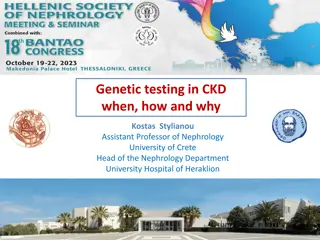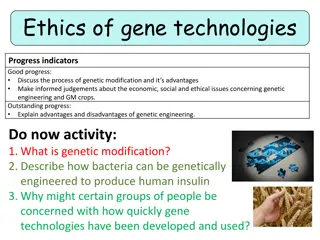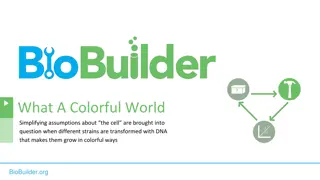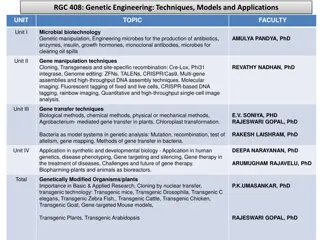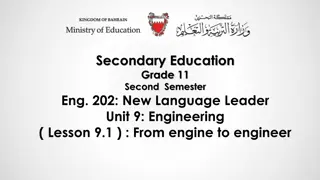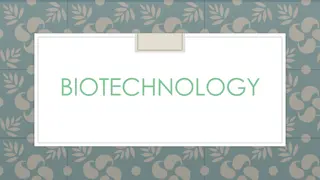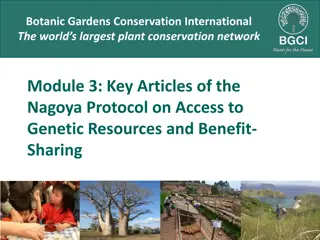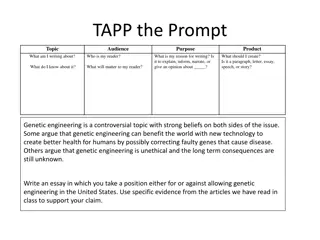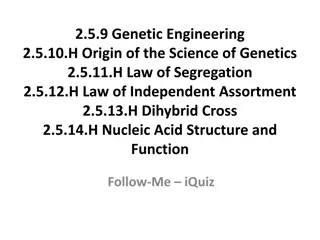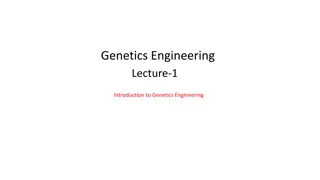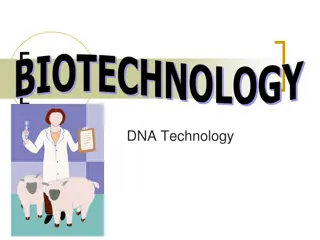Exploring Genetic Engineering: From Basics to Applications
Genetic engineering involves altering the genetic material of organisms to achieve desirable traits. This process entails cutting out specific genes from one organism and transferring them to another. In medicine, genetic engineering finds applications in gene therapy, hormone production, and vaccine development. However, there are economic, social, and ethical considerations related to genetically modified crops. The technique of embryo screening for genetic disorders raises concerns about potential risks and ethical implications.
Download Presentation

Please find below an Image/Link to download the presentation.
The content on the website is provided AS IS for your information and personal use only. It may not be sold, licensed, or shared on other websites without obtaining consent from the author. Download presentation by click this link. If you encounter any issues during the download, it is possible that the publisher has removed the file from their server.
E N D
Presentation Transcript
Genetic Engineering Progress indicators Good progress: Define the term genetic engineering. Describe the process of genetic engineering and its advantages. Outstanding progress: Evaluate the use of genetic engineering in medicine, eg in gene therapy and production of hormones and some vaccines. Make informed judgements about the economic, social and ethical issues concerning GM crops. Do now activity: 1. Identify two genetic disorders and describe the symptoms of one of them 2. Describe the two ways in which an embryo can be screened for a genetic disorder 3. Explain some the potential risks and concerns of embryo screening
Think > Pair > Share: What is genetic engineering? Genetic engineering involves changing the genetic material of an organism. This is achieved by cutting the desirable gene from one organism and transferring it to the cells of another organism.
How is genetic engineering carried out? Task: Watch the video and answer the following questions: 1. What is used to cut out a section of the DNA from the genome of an organism? 2. What is a plasmid? 3. The pieces of frog DNA are mixed with cut plasmids, what is the aim of this stage of the process? 4. What is the job of DNA ligase? 5. What is the job of the marker in the plasmid? 6. What happens to the bacteria once the cells have taken up the plasmids? 7. Once the bacteria have grown the plasmids are extracted, how do we identify the plasmid containing the gene we actually want? https://ed.ted.com/on/bhmjqvQ9
Self-assessment: A restriction enzyme is used to cut out a section of the DNA from the genome of an organism. 2. A plasmid is a circular piece of DNA found in most bacteria 3. The aim of this stage is for the pieces of frog DNA to attach to the open parts of the plasmid. 4. The job of DNA ligase is to attach the section of DNA to the cut open ends of the plasmid. 5. The marker ensures antibiotic resistance against a certain antibiotic 6. Once the bacteria have taken up the plasmids into their cells they are now plated up onto agar plates which contain the specific antibiotic. 7. Gel electrophoresis is a process which separates genes according to size, so we can run the genes through this process to identify the frog gene we want to make lots of copies of. 1.
Task: Draw the diagram below and identify the correct statements for each step from the list below 2. 6. 1. 5. 7. 4. Insulin 3. The plasmid is inserted back into the bacteria cell The plasmid is taken out of the bacteria and split open using restriction enzymes Human cell containing normal insulin gene The insulin gene is inserted into the bacterium s plasmid The bacteria cells divide to make more bacteria, all contain the human insulin gene The insulin gene is cut out of the human genome using restriction enzymes Bacteria cell containing plasmid of DNA
Self-assessment: Human cell containing normal insulin gene 1. 2. The insulin gene is cut out of the human genome using restriction enzymes 3. Bacteria cell containing plasmid of DNA 4. The plasmid is taken out of the bacteria and split open using restriction enzymes 5. The insulin gene is inserted into the bacterium s plasmid 6. The plasmid is inserted back into the bacteria cell 7. The bacteria cells divide to make more bacteria, all contain the human insulin gene
Gene modification of crops Crops that have had their genes modified by genetic engineering are known as genetically modified crops, or GM crops. Different groups of people have different opinions on the growth and consumption of GM crops. Task: Watch the following videos and try and come up with a list of advantages of disadvantages of growing, selling and eating GM crops. AdvantagesDisadvantages
There are many benefits of GM crops in providing food for the world s population, including: Genetically modified crops include plants that have been engineered to release their own pesticide, this means more of the crops survive which equals a higher yield and ultimately more food for more people. GM plants can be more resistant to herbicides which means farmers can kill weeds more effectively without damaging crops GM crops can be engineered to be more resistant to common diseases such as mosaic viruses. There are hopes for the future that GM crops could be engineered to take in more carbon dioxide to help combat global warming Sometimes genetic modification can help to increase the size of the fruit or increase the nutritional content of the crop.
Task: Consider the view points of the following people on the production and consumption of GM crops. Come up with a statement from each of them on this topic. GM scientist Organic farmer GCSE students An organiser for a world hunger charity
Exam-style question Q.Insulin can be produced using a genetic engineering process. Complete the gaps to explain this process: The first step in this process is that a special ________ is used to cut the insulin gene out of the human _________. In another step, a bacterial __________ is cut open using a special _________. These two pieces of genetic material are combined together form a new plasmid and this is inserted back into the _________ cell. (5 marks) 5 marks = 5 minutes
Self-assessment: The first step in this process is that a special enzyme is used to cut the insulin gene out of the human chromosome. In another step, a bacterial plasmid is cut open using a special enzyme. These two pieces of genetic material are combined together form a new plasmid and this is inserted back into the bacteria cell.
Plenary ~ Pick a task: Link the following key words in a summary sentence about today: If these are the answers, what could the questions be: a) Gene b) Plasmid c) Restriction enzyme d) Genetic engineering Gene, chromosome, human, bacteria, insulin, genetic engineering, plasmid


